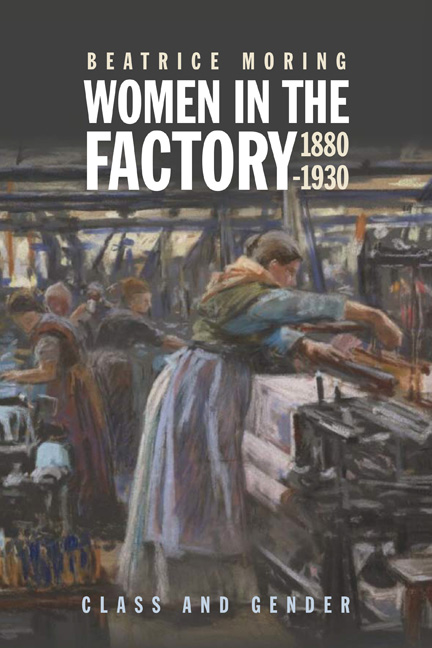Book contents
- Frontmatter
- Contents
- List of Illustrations
- Introduction – Why Women in the Factory?
- 1 Gender And Class – Male Unions, Political Movements and the Female Vote
- 2 Women in Industry: Work, Sectors, Age and Marital Status
- 3 Women, Earnings and the Household – Why the Factory?
- 4 Accidents, Compensation, Laws and Inspection
- 5 Middle Class Girls, Education and Entry into the Civil Service
- 6 The Female Factory Inspectors – How, Why and Who
- 7 Factory Inspection Activity
- 8 Class, Gender and Communication
- Conclusion
- Appendix 1 The Right for Women to Vote in National Elections
- Appendix 2 Women in the Workforce
- Appendix 3 Women, Work, Earnings and Family
- Appendix 4 Accidents, Workplace Acts and Regulations
- Appendix 5 Education
- Appendix 6 Female Inspectors
- Appendix 7 Inspectors, Activity
- Appendix 8 The Female Inspectors and Society
- Bibliography
- Index
3 - Women, Earnings and the Household – Why the Factory?
Published online by Cambridge University Press: 09 May 2024
- Frontmatter
- Contents
- List of Illustrations
- Introduction – Why Women in the Factory?
- 1 Gender And Class – Male Unions, Political Movements and the Female Vote
- 2 Women in Industry: Work, Sectors, Age and Marital Status
- 3 Women, Earnings and the Household – Why the Factory?
- 4 Accidents, Compensation, Laws and Inspection
- 5 Middle Class Girls, Education and Entry into the Civil Service
- 6 The Female Factory Inspectors – How, Why and Who
- 7 Factory Inspection Activity
- 8 Class, Gender and Communication
- Conclusion
- Appendix 1 The Right for Women to Vote in National Elections
- Appendix 2 Women in the Workforce
- Appendix 3 Women, Work, Earnings and Family
- Appendix 4 Accidents, Workplace Acts and Regulations
- Appendix 5 Education
- Appendix 6 Female Inspectors
- Appendix 7 Inspectors, Activity
- Appendix 8 The Female Inspectors and Society
- Bibliography
- Index
Summary
A shilling of your own is worth two that he gives you.
Research on the subject of women and work has for decades underlined that women were underpaid in relation to men, and that women not only had tasks with less respect but were also forced to labour under inhuman conditions, particularly in factories. This might inspire the question, if factory work was so horrible for women (unlike for men?) why did women enter the factories?
In retrospect there is never a shortage of good ideas and suggestions about what would have been a sensible choice, and the late nineteenth and early twentieth centuries supplied their fair share of social reformers and people with views about how the working classes should live and the need to get women out of the factories.
Working-class women and families of the past were painfully aware of their need to eat, and the differences in male and female earnings were not restricted to factory employment. Whatever work a woman chose to do, she would earn less than a man. Today we talk about equal pay, which even though guaranteed by law, is not actually a reality in Western countries. In the past, women had to take reality into consideration and deal with whatever choices were available. In such a situation the factory might not have been the worst option. Middle-class social reformers considered domestic service as a suitable job for young women: it was safe and in a family, under control of ‘respectable people’ and girls would acquire domestic skills that would be useful when they married and became wives and mothers. In actual fact, the work was badly paid, had terrible hours, no freedom and privacy, no job security and in case of pregnancy, resulted in loss both of employment and home. While farm work was also badly paid, the social distance between employer and employee could be a lot closer. In addition, in many parts of Europe, rural society handled the question of pregnancy more smoothly; there were even regions, most prominently in German-speaking parts of Europe and Iceland, where mothers could keep their children with them when employed as live-in farm workers.
- Type
- Chapter
- Information
- Women in the Factory, 1880-1930Class and Gender, pp. 59 - 91Publisher: Boydell & BrewerPrint publication year: 2024



